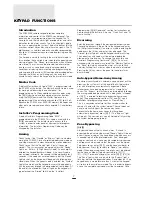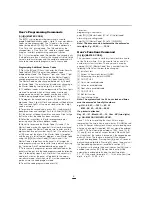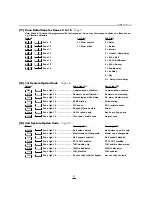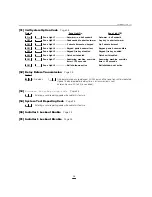
19
transmission and periodic download both use the same
cycle time which is set in section [22] and the same time of
day as set in section [23]. The test transmission is sent to
the monitoring station to confirm that the communication link
is intact. The reporting code must be programmed in
section [15]. The periodic download must be used in
conjunction with the downloading computer “waiting for a
panel to call”.
[23] System Clock Times
After the section number [23] is entered, three 4 digit
numbers are expected. These numbers are the following
system times:
• Automatic arming time of day (HH:MM)
• For future use (99:99)
• Test transmission time of day (HH:MM)
Times are entered using the “24 hour clock” (military time).
Valid entries are 00 to 23 for HH (i.e. hours) and 00 to 59 for
MM (i.e. minutes).
Note: IF INVALID TIMES ARE
ENTERED FUNCTIONS WILL NOT WORK. The automatic
arm function is enabled and disabled using the
[Q][6][Master Code] User’s Functions Command.
[24] New Installer’s Code
[25] New Master Code
(Access Code Number
1)
[26] Downloading Access Code
Enter a new 4 digit code in each of sections 24, 25 and 26
once the section number has been entered. Only use digits
0 to 9 as code numbers. Do not press the [
Q
] or [#] keys. If
an error is made in entering a code, continue to enter the
four digits then enter the section number again and re-enter
the correct code. Do not press the [
Q
] or [#] while entering
these codes. Do not make any of the three codes the same.
[27] Communicator Format Options
This section sets the type of format which will be sent to
each of the two telephone numbers programmed in sections
[1] and [3]. Enter one HEX digit (i.e. when entering HEX “A”
press [
Q
][1][
Q
]) for each. The number entered for each
phone number is determined by the requirements of the
receiver being called. Enter the format number for the “1st
Telephone Number” first. It is necessary to program the
format number for each telephone number even if the first
phone number is the only one being used. Options are as
follows.
[0] Silent Knight/Ademco slow, 10 BPS (1400 Hz
handshake) 3/1 and 4/1, 4/2 non extended format
[1] Sescoa, Franklin, DCI, Vertex, 20 BPS (2300 Hz
handshake) 3/1 and 4/1, 4/2 non extended format
[2] Silent Knight fast, 20 BPS (1400 Hz handshake)
3/1 and 4/1, 4/2 non extended format
[3] Radionics, (2300/1400 Hz handshake)
3/1, 4/2 non extended format
[4] Radionics, (2300/1400 Hz handshake)
3/1, 4/2 non extended with parity format
[5] Sescoa super speed
[6] Not used
[7] Not used
[8] Silent Knight/Ademco slow, 10 BPS (1400 Hz
handshake)
3/1 extended format
[9] Sescoa, Franklin, DCI, Vertex, 20 BPS (2300 Hz
handshake) 3/1 extended format
[A] Silent Knight/Ademco fast, 20 BPS (1400 Hz handshake)
3/1 extended format
[B] Radionics, (2300/1400 Hz handshake) 3/1 extended
format
[C] Radionics, (2300/1400 Hz handshake) 3/1 extended with
parity format
[D] Sescoa super speed (with identified openings/closings)
[E] Not used
[F] Not used
10 BPS and 20 BPS Formats
10 BPS is the standard slow format used on Silent Knight/
Ademco receivers.
DATA=1900 Hz
KISSOFF=1400 Hz
SPEED=10 BAUD
20 BPS is the standard fast format used on DCI, Franklin,
Sescoa and Vertex receivers.
DATA=1800 Hz
KISSOFF=2300 Hz
SPEED=20 BAUD
Radionics Format
For conventional 3/1 Radionics format the communications
mode should be set to either Radionics rounds [B] or
Radionics parity [C]. The extended version of the Radionics
format is normally used. The following guidelines have been
provided to help in configuring the PC3000 for Radionics
format.
1. The customer account code must be only 3 digits with a
zero making up the 4th digit (i.e. program 1230 for
account code 123).
2. The zone alarm reporting codes must all be single digit
numerical codes with no extended 2nd round being
sent. The zero in the 2nd digit of the reporting code tells
the
PC3000 not to send an extended round.
3. All other non-alarm reporting codes must be set up to
send an extended 2nd round. The 1st digit of the
reporting code is used to identify the event while the 2nd
or extended digit is used to associate the event with a
particular item. (i.e. A reporting code of E3 means restore
zone 3. E for
restore and 3 for zone 3.)
4. The following is a list of 1st digit identifiers that should be
used with the Radionics format.
Restorals “E” Example “E3” = Restore Zone 3
Openings “B” Example “B2” = Opening by User 2
Closings “C”
Example “C4”= Closing by User 4
Troubles “F”
Example “F5” = Trouble from Source 5
Misc “D”
Example “D1”= Partial Closing
Summary of Contents for PC3OOO
Page 1: ...INSTALLATION MANUAL PC3OOO Version 7 51...
Page 40: ...HOOKUP DIAGRAMS 36...
Page 44: ...29000543 R7...
















































